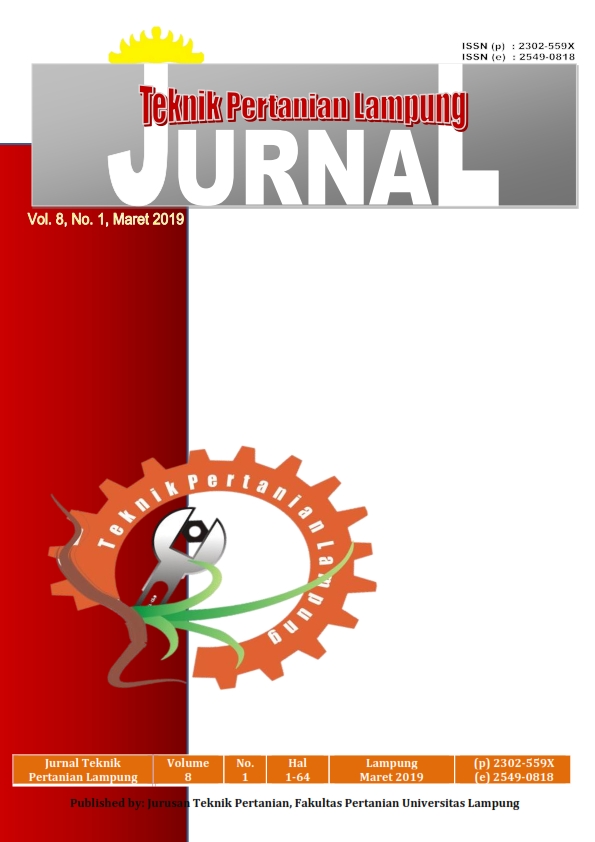Uji Kinerja Unit Mesin Pasteurisasi Tipe Kontinyu untuk Pengolahan Sari Buah Sirsak
DOI:
https://doi.org/10.23960/jtep-l.v8i1.10-19Abstract
Soursop fruit is one of the horticultural products that are easily damaged after the maturation process. This fruit is generally consumed in the form of fresh ripe or juice. The quality of the fruit is also very diverse and at harvest time the amount is abundant so the selling price tend to be low. One alternative to increase the added value of soursop fruit which the quality is poor and to extend the shelf life can be done through processing into juice. This study aims to test the performance of continuous type pasteurizer unit which has been developed by the Indonesian Center for Agricultural Engineering research and Development (ICAERD) in the processing of soursop juice on a small scale industry. The pasteurizer unit consists of a mixer, pasturizer, holder, filler, and cup sealer. The process of soursop juice processing includes fruit bunching, skin peeling, burial, mixing and dilution of slurry, fruit juice pasturization, and packaging. The pasteurization process was done at 80 °C for 5-10 minutes. The pasteurization temperature is achieved at pavor pressure on water heating tube of about 1.0-1,5 bar. Under these conditions the capacity of continuous type pasteurizer unit was 160 l/h. The resulting juice has a TPC content on days 0, 7, and 14 after storage was 4.8 x 102, 5.1 x 102, and 1.9 x 103 cfu/g, respectively. The heavy metal content of Cu and Pb were 0.63 and 0.29 ppm, respectively.
Keywords: performance test, pasteurizer, continuous type, soursop juice processing, value added product.References
Agung. T. 2009. Prinsip Pasteurisasi dan Sterilisasi Komersial Produk Pangan. http://id.shvoong.com/exact-sciences/1799738-prinsip-pasteurisasi-dan-sterilisasi-komersial/.
Ashurst, P.R. 1998. The Chemistry and Technology of Soft Drink and Fruit Juices. England: Sheffield Academic Press.
Maresca, P., Donsi, F., Ferrari, G. 2011. Application of multi-pass high-pressure homogenization treatment for the pasteurization of fruit juices. Journal of Food Engineering. 104: 364-372.
Satuhu, S., 1996. Penanganan dan Pengolahan Buah. Penebar Swadaya, Jakarta.
Sampedro, F., McAloon, A., Yee, W., Fan, X., Zhang, H.Q., Geveke, D. J. 2013. Cost analysis of commercial pasteurization of orange juice by pulsed electric fields. Innovative Food Science & Emerging Technologies. 17: 72-78.
Suyatno. 2001. Studi Prototipe Alat Pasteurisasi Proses Penahanan (Holding) dengan Aliran Bahan Kontinyu untuk Inaktivasi Bakteri Clostridium pasteurianum dalam Sari Buah Tomat. Jurusan Teknologi Pertanian. FTP. UniBraw. Malang.
Tucker, G. S., Lambourne, T., Adams, J. B., Lach, A. 2002. Application of a biochemichal time-temperature integrator to estimate pasteurization values in continuous food process. Innovative Food Science & Emerging Technologies. 3: 165-174.
Umme, A., Asbi, B.A., Salmah, Y., Junainah, A.H, and Jamilah, B. 1997. Characteristics of soursop natural puree and determination of optimum conditions for pasteurization. J. Food Chemistry. 58: 119-124.
Umme, A., Asbi, B.A., Salmah, Y., Junainah, A.H, and Jamilah, B. 1997. Microbial and enzymatic changes in natural soursop puree during storage. J. Food Chemistry. 67: 315-322.
Unadi, A., Setyadjit, Sukasih, E. 2005. Rancang bangun mesin pasteurisasi puree. Prosiding Seminar Nasional Teknologi Inovatif Pascapanen untuk Pengembangan Industri Berbasis Pertanian. Institut Pertanian Bogor. Bogor.
Downloads
Published
Issue
Section
License
- Authors who publish with this journal agree to the following terms:
- Authors retain copyright and grant the journal right of first publication with the work simultaneously licensed under a Creative Commons Attribution-ShareAlike 4.0 International Lice that allows others to share the work with an acknowledgement of the work's authorship and initial publication in this journal.
- Authors are able to enter into separate, additional contractual arrangements for the non-exclusive distribution of the journal's published version of the work (e.g., post it to an institutional repository or publish it in a book), with an acknowledgement of its initial publication in this journal.
- Authors are permitted and encouraged to post their work online (e.g., in institutional repositories or on their website) prior to and during the submission process, as it can lead to productive exchanges, as well as earlier and greater citation of published work (See The Effect of Open Access).
Jurnal Teknik Pertanian Lampung

JTEPL is licensed under a Creative Commons Attribution-ShareAlike 4.0 International License.

